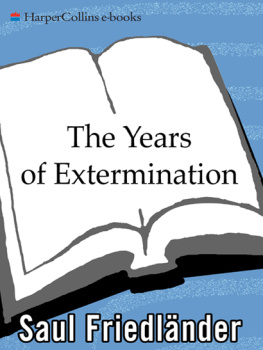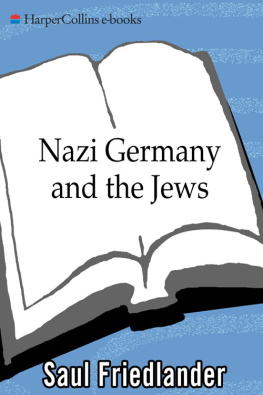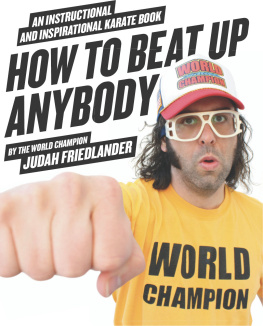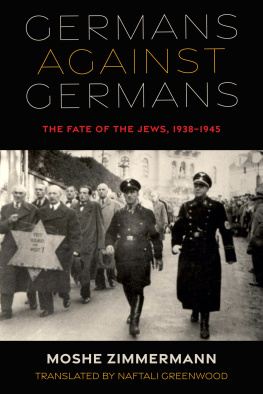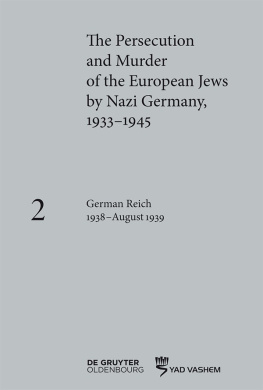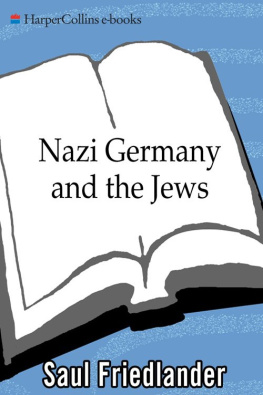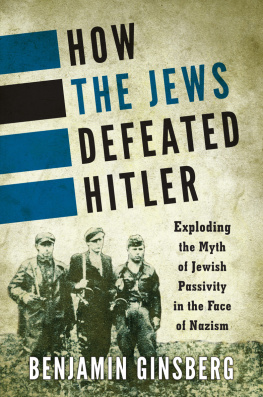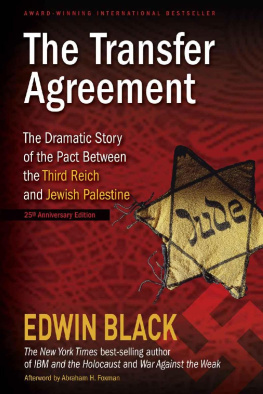The Years of Extermination
Nazi Germany and the Jews, 1939-1945
Saul Friedlnder

To Yonatan
The struggle to save myself is hopeless. But thats not important. Because I am able to bring my account to its end and trust that it will see the light of day when the time is right. And people will know what happened. And they will ask, is this the truth? I reply in advance: No, this is not the truth, this is only a small part, a tiny fraction of the truth. Even the mightiest pen could not depict the whole, real, essential truth .
Stefan Ernest, The Warsaw Ghetto, written in hiding in 1943 on the Aryan side of Warsaw.
Contents
Terror (Fall 1939Summer 1941)
September 1939May 1940
May 1940December 1940
December 1940June 1941
Mass Murder (Summer 1941Summer 1942)
June 1941September 1941
September 1941December 1941
December 1941July 1942
Shoah (Summer 1942Spring 1945)
July 1942March 1943
March 1943October 1943
October 1943March 1944
March 1944May 1945
This work has greatly benefited from the research funds provided by the 1939 Club chair at UCLA and, in particular, from an incomparably generous fellowship from the John D. and Catherine T. MacArthur Foundation. To the 1939 Club and to the MacArthur Foundation I wish to express my deepest gratitude.
I wish, first, to mention in fond memory the friends, all departed now, with whom I shared many thoughts about the history dealt with here: Lon Poliakov, Uriel Tal, Amos Funkenstein, and George Mosse.
Professor Michael Wildt (Hamburg Institut fr Sozialforschung) had the kindness to read an almost final version of the manuscript; I feel very grateful for his comments: He drew my attention to recent German research and mainly helped me to avoid some mistakes, as did Dr. Dieter Pohl of the Institute of Contemporary History (Munich) and Professor Eberhard Jckel (University of Stuttgart). I am equally thankful to Professors Omer Bartov (Brown University), Dan Diner (Hebrew University, Jerusalem, and the Simon Dubnow Institute, Leipzig) and Norbert Frei (Jena University) for having commented on various parts of the text.
Notwithstanding my recurring doubts, I was encouraged over time to complete this project by many colleagues, particularly professors Yehuda Bauer, Dov Kulka, and Steve Aschheim (all from the Hebrew University, Jerusalem), Professor Shulamit Volkov (Tel Aviv University), Professor Philippe Burrin (director of the Graduate Institute of International Studies in Geneva), and the late Dr. Sybil Milton, a wonderful scholar and the most selfless of colleagues, whose untimely passing was a grievous loss.
Of course, as the formula goes, the responsibility for the (certainly many) mistakes remaining in the text is solely mine.
I remained dependent throughout this entire project upon a succession of graduate students. All should be thanked here in the persons of my most recent research assistants: Deborah Brown, Amir Kenan, and Joshua Sternfeld.
Both Susan H. Llewellyn and David Koral of HarperCollins have applied their considerable linguistic skills to the copyediting of this manuscript. I am very grateful to them and, of course, most thankful for the constant attention and encouragement provided by my editor, Hugh Van Dusen. The assistant editor, Rob Crawford, has shown patience beyond the call of duty in dealing with my frequent inquiries. And, to my agents and friends, Georges, Anne, and Valerie Borchardt, I wish to express again my heartfelt thanks. My personal and professional relations with Georges and Anne go back to the publication of my first book in the United States ( Pius XII and the Third Reich ), in 1966.
This work owes more than I can say to Orna Kenans emotional and intellectual support; she shares my life. The book is dedicated to my newly born fourth grandson.
David Moffie was awarded his degree in medicine at the University of Amsterdam on September 18, 1942. In a photograph taken at the event, Professor C. U. Ariens Kappers, Moffies supervisor, and Professor H. T. Deelman stand on the right of the new MD, and assistant D. Granaat stands on the left. Another faculty member, seen from the back, possibly the dean of the medical school, stands just behind a large desk. In the dim background, the faces of some of the people crowded into the rather cramped hall, family members and friends no doubt, are barely discernible. The faculty members have donned their academic robes, while Moffie and Granaat wear tuxedos and white ties. On the left side of his jacket Moffie displays a palm-size Jewish star with the word Jood inscribed on it. Moffie was the last Jewish student at the University of Amsterdam under German occupation.
The usual terms of praise and thanks were certainly uttered according to academic ritual. We do not know whether any other comments were added. Shortly thereafter Moffie was deported to Auschwitz-Birkenau. He survived, as did 20 percent of the Jews of Holland; according to the same statistics, therefore, most of the Jews present at the ceremony did not.
The picture raises some questions. How, for example, could the ceremony have taken place on September 18, 1942, when Jewish students were excluded from Dutch universities as of September 8? The editors of Photography and the Holocaust found the answer: The last day of the 194142 university year was Friday, September 18, 1942; the 194243 semester started on Monday, September 21. The three-day break allowed Moffie to receive his degree before the ban on Jewish students became mandatory.
Actually the break was limited to precisely one weekend (Friday, September 18Monday, September 21), meaning that the university authorities agreed to use the administrative calendar against the intention of the German decree. This decision signaled an attitude widespread at Dutch universities since the fall of 1940; the photograph documents an act of defiance, on the edge of the occupiers laws and decrees.
There is more. The deportations from Holland started on July 14, 1942. Almost daily Germans and local police arrested Jews on the streets of Dutch cities to fill the weekly quotas. Moffie could not have attended this public academic ceremony without having received one of the seventeen thousand special (and temporary) exemption certificates the Germans allocated to the citys Jewish Council. The picture thus indirectly evokes the controversy surrounding the methods used by the heads of the council to protectfor a time at leastsome of the Jews of Amsterdam while abandoning the great majority to their fate.
In the most general terms we are witnessing a common enough ceremony, easy to recognize. Here, in a moderately festive setting, a young man received official confirmation that he was entitled to practice medicine, to take care of the sick, and as far as humanly possible, to use his professional knowledge in order to restore health. But, as we know, the Jood pinned to Moffies coat carried a very different message: Like all members of his race throughout the Continent, the new MD was marked for murder.
Faintly seen, the Jood does not appear in block letters or in any other commonly used script. The characters were specially designed for this particular purpose (and similarly drawn in the languages of the countries of deportation: Jude, Juif, Jood, and so on) in a crooked, repulsive, and vaguely threatening way, intended to evoke the Hebrew alphabet and yet remain easily decipherable. And it is in this inscription and its peculiar design that the situation represented in the photograph reappears in its quintessence: The Germans were bent on exterminating the Jews as individuals, and on erasing what the star and its inscription representedthe Jew.

